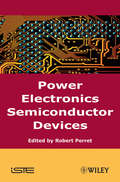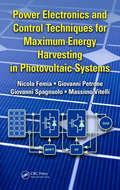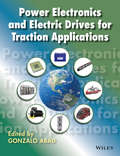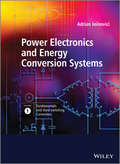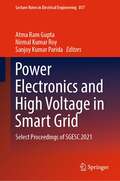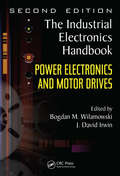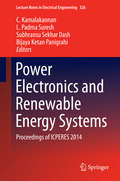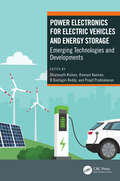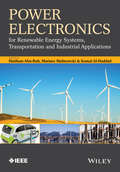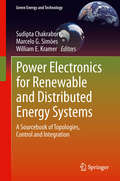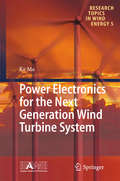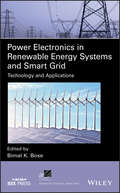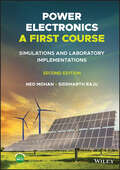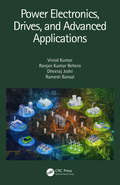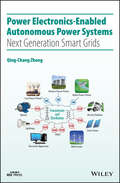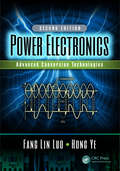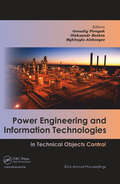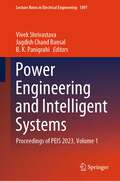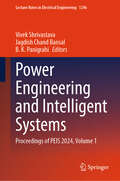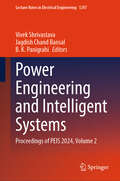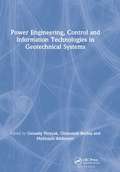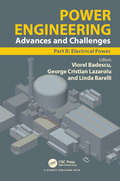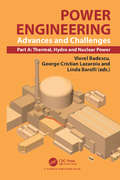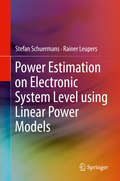- Table View
- List View
Power Electronics Semiconductor Devices (Wiley-iste Ser.)
by Robert PerretThis book relates the recent developments in several key electrical engineering R&D labs, concentrating on power electronics switches and their use. The first sections deal with key power electronics technologies, MOSFETs and IGBTs, including series and parallel associations. The next section examines silicon carbide and its potentiality for power electronics applications and its present limitations. Then, a dedicated section presents the capacitors, key passive components in power electronics, followed by a modeling method allowing the stray inductances computation, necessary for the precise simulation of switching waveforms. Thermal behavior associated with power switches follows, and the last part proposes some interesting prospectives associated to Power Electronics integration.
Power Electronics and Control Techniques for Maximum Energy Harvesting in Photovoltaic Systems (Industrial Electronics #11)
by Giovanni Petrone Giovanni Spagnuolo Nicola Femia Massimo VitelliIncentives provided by European governments have resulted in the rapid growth of the photovoltaic (PV) market. Many PV modules are now commercially available, and there are a number of power electronic systems for processing the electrical power produced by PV systems, especially for grid-connected applications. Filling a gap in the literature, Power Electronics and Control Techniques for Maximum Energy Harvesting in Photovoltaic Systems brings together research on control circuits, systems, and techniques dedicated to the maximization of the electrical power produced by a photovoltaic (PV) source. Tools to Help You Improve the Efficiency of Photovoltaic Systems The book supplies an overview of recent improvements in connecting PV systems to the grid and highlights various solutions that can be used as a starting point for further research and development. It begins with a review of methods for modeling a PV array working in uniform and mismatched conditions. The book then discusses several ways to achieve the best maximum power point tracking (MPPT) performance. A chapter focuses on MPPT efficiency, examining the design of the parameters that affect algorithm performance. The authors also address the maximization of the energy harvested in mismatched conditions, in terms of both power architecture and control algorithms, and discuss the distributed MPPT approach. The final chapter details the design of DC/DC converters, which usually perform the MPPT function, with special emphasis on their energy efficiency. Get Insights from the Experts on How to Effectively Implement MPPT Written by well-known researchers in the field of photovoltaic systems, this book tackles state-of-the-art issues related to how to extract the maximum electrical power from photovoltaic arrays under any weather condition. Featuring a wealth of examples and illustrations, it offers practical guidance for researchers and industry professionals who want to implement MPPT in photovoltaic systems.
Power Electronics and Electric Drives for Traction Applications
by Gonzalo AbadPower Electronics and Electric Drives for Traction Applications offers a practical approach to understanding power electronics applications in transportation systems ranging from railways to electric vehicles and ships. It is an application-oriented book for the design and development of traction systems accompanied by a description of the core technology. The first four introductory chapters describe the common knowledge and background required to understand the preceding chapters. After that, each application-specific chapter: highlights the significant manufacturers involved; provides a historical account of the technological evolution experienced; distinguishes the physics and mechanics; and where possible, analyses a real life example and provides the necessary models and simulationtools, block diagrams and simulation based validations. Key features: Surveys power electronics state-of-the-art in all aspects of traction applications. Presents vital design and development knowledge that is extremely important for the professional community in an original, simple, clear and complete manner. Offers design guidelines for power electronics traction systems in high-speed rail, ships, electric/hybrid vehicles, elevators and more applications. Application-specific chapters co-authored by traction industry expert. Learning supplemented by tutorial sections, case studies and MATLAB/Simulink-based simulations with data from practical systems. A valuable reference for application engineers in traction industry responsible for design and development of products as well as traction industry researchers, developers and graduate students on power electronics and motor drives needing a reference to the application examples.
Power Electronics and Energy Conversion Systems, Fundamentals and Hard-switching Converters
by Adrian IoinoviciPower Electronics and Energy Conversion Systems is a definitive five-volume reference spanning classical theory through practical applications and consolidating the latest advancements in energy conversion technology. Comprehensive yet highly accessible, each volume is organised in a basic-to-sophisticated crescendo, providing a single-source reference for undergraduate and graduate students, researchers and designers.Volume 1 Fundamentals and Hard-switching Converters introduces the key challenges in power electronics from basic components to operation principles and presents classical hard- and soft-switching DC to DC converters, rectifiers and inverters. At a more advanced level, it provides comprehensive analysis of DC and AC models comparing the available approaches for their derivation and results. A full treatment of DC to DC hard-switching converters is given, from fundamentals to modern industrial solutions and practical engineering insight. The author elucidates various contradictions and misunderstandings in the literature, for example, in the treatment of the discontinuous conduction operation or in deriving AC small-signal models of converters.Other key features:* Consolidates the latest advancements in hard-switching converters including discontinuous capacitor voltage mode, and their use in power-factor-correction applications* Includes fully worked design examples, exercises, and case studies, with discussion of the practical consequences of each choice made during the design* Explains all topics in detail with step-by-step derivation of formulas appropriate for energy conversion courses* End-of-section review of the learned material* Includes topics treated in recent journal, conference and industry application coverage on solutions, theory and practical concernsWith emphasis on clear explanation, the text offers both a thorough understanding of DC to DC converters for undergraduate and graduate students in power electronics, and more detailed material suitable for researchers, designers and practising engineers working on the development and design of power electronics. This is an accessible reference for engineering and procurement managers from industries such as consumer electronics, integrated circuits, aerospace and renewable energy.
Power Electronics and High Voltage in Smart Grid: Select Proceedings of SGESC 2021 (Lecture Notes in Electrical Engineering #817)
by Atma Ram Gupta Nirmal Kumar Roy Sanjoy Kumar ParidaThe book contains select proceedings of the International Conference on Smart Grid Energy Systems and Control (SGESC 2021). The proceedings is divided into 03 volumes, and this volume focuses on power electronics, machines, systems integrations, and high voltage engineering. This book is a unique collection of chapters from different areas with a common theme and will be immensely useful to academic researchers and practitioners in the industry.
Power Electronics and Motor Drives
by Richard C. DorfThe Industrial Electronics Handbook, Second Edition combines traditional and newer, more specialized knowledge that will help industrial electronics engineers develop practical solutions for the design and implementation of high-power applications. Embracing the broad technological scope of the field, this collection explores fundamental areas, including analog and digital circuits, electronics, electromagnetic machines, signal processing, and industrial control and communications systems. It also facilitates the use of intelligent systems—such as neural networks, fuzzy systems, and evolutionary methods—in terms of a hierarchical structure that makes factory control and supervision more efficient by addressing the needs of all production components. Enhancing its value, this fully updated collection presents research and global trends as published in the IEEE Transactions on Industrial Electronics Journal, one of the largest and most respected publications in the field. Power Electronics and Motor Drives facilitates a necessary shift from low-power electronics to the high-power varieties used to control electromechanical systems and other industrial applications.This volume of the handbook: Focuses on special high-power semiconductor devices Describes various electrical machines and motors, their principles of operation, and their limitations Covers power conversion and the high-efficiency devices that perform the necessary switchover between AC and DC Explores very specialized electronic circuits for the efficient control of electric motors Details other applications of power electronics, aside from electric motors—including lighting, renewable energy conversion, and automotive electronics Addresses power electronics used in very-high-power electrical systems to transmit energy Other volumes in the set: Fundamentals of Industrial Electronics Control and Mechatronics Industrial Communication Systems Intelligent Systems
Power Electronics and Renewable Energy Systems
by Bijaya Ketan Panigrahi L. Padma Suresh Subhransu Sekhar Dash C. KamalakannanThe book is a collection of high-quality peer-reviewed research papers presented in the Proceedings of International Conference on Power Electronics and Renewable Energy Systems (ICPERES 2014) held at Rajalakshmi Engineering College, Chennai, India. These research papers provide the latest developments in the broad area of Power Electronics and Renewable Energy. The book discusses wide variety of industrial, engineering and scientific applications of the emerging techniques. It presents invited papers from the inventors/originators of new applications and advanced technologies.
Power Electronics for Electric Vehicles and Energy Storage: Emerging Technologies and Developments
by Dharavath Kishan, Ramani Kannan, B Dastagiri Reddy, and Prajof PrabhakaranThis text will help readers to gain knowledge about designing power electronic converters and their control for electric vehicles. It discusses the ways in which power from electric vehicle batteries is transferred to an electric motor, the technology used for charging electric vehicle batteries, and energy storage. The text covers case studies and real-life examples related to electric vehicles. The book • Discusses the latest advances and developments in the field of electric vehicles • Examines the challenges associated with the integration of renewable energy sources with electric vehicles • Highlights basic understanding of the charging infrastructure for electric vehicles • Covers concepts including the reliability of power converters in electric vehicles, and battery management systems. This book discusses the challenges, emerging technologies, and recent development of power electronics for electric vehicles. It will serve as an ideal reference text for graduate students and academic researchers in the fields of electrical engineering, electronics and communication engineering, environmental engineering, automotive engineering, and computer science.
Power Electronics for Renewable Energy Systems, Transportation and Industrial Applications
by Haitham Abu-Rub Kamal Al-Haddad Mariusz MalinowskiCompiles current research into the analysis and design of power electronic converters for industrial applications and renewable energy systems, presenting modern and future applications of power electronics systems in the field of electrical vehiclesWith emphasis on the importance and long-term viability of Power Electronics for Renewable Energy this book brings together the state of the art knowledge and cutting-edge techniques in various stages of research. The topics included are not currently available for practicing professionals and aim to enable the reader to directly apply the knowledge gained to their designs. The book addresses the practical issues of current and future electric and plug-in hybrid electric vehicles (PHEVs), and focuses primarily on power electronics and motor drives based solutions for electric vehicle (EV) technologies. Propulsion system requirements and motor sizing for EVs is discussed, along with practical system sizing examples. Key EV battery technologies are explained as well as corresponding battery management issues. PHEV power system architectures and advanced power electronics intensive charging infrastructures for EVs and PHEVs are detailed. EV/PHEV interface with renewable energy is described, with practical examples. This book explores new topics for further research needed world-wide, and defines existing challenges, concerns, and selected problems that comply with international trends, standards, and programs for electric power conversion, distribution, and sustainable energy development. It will lead to the advancement of the current state-of-the art applications of power electronics for renewable energy, transportation, and industrial applications and will help add experience in the various industries and academia about the energy conversion technology and distributed energy sources. Combines state of the art global expertise to present the latest research on power electronics and its application in transportation, renewable energy and different industrial applicationsOffers an overview of existing technology and future trends, with discussion and analysis of different types of converters and control techniques (power converters, high performance power devices, power system, high performance control system and novel applications)Systematic explanation to provide researchers with enough background and understanding to go deeper in the topics covered in the book
Power Electronics for Renewable and Distributed Energy Systems
by Marcelo G. Simões Sudipta Chakraborty William E. KramerWhile most books approach power electronics and renewable energy as two separate subjects, Power Electronics for Renewable and Distributed Energy Systems takes an integrative approach; discussing power electronic converters topologies, controls and integration that are specific to the renewable and distributed energy system applications. An overview of power electronic technologies is followed by the introduction of various renewable and distributed energy resources that includes photovoltaics, wind, small hydroelectric, fuel cells, microturbines and variable speed generation. Energy storage systems such as battery and fast response storage systems are discussed along with application-specific examples. After setting forth the fundamentals, the chapters focus on more complex topics such as modular power electronics, microgrids and smart grids for integrating renewable and distributed energy. Emerging topics such as advanced electric vehicles and distributed control paradigm for power system control are discussed in the last two chapters. With contributions from subject matter experts, the diagrams and detailed examples provided in each chapter make Power Electronics for Renewable and Distributed Energy Systems a sourcebook for electrical engineers and consultants working to deploy various renewable and distributed energy systems and can serve as a comprehensive guide for the upper-level undergraduates and graduate students across the globe.
Power Electronics for the Next Generation Wind Turbine System
by Ke MaThis book presents recent studies on the power electronics used for the next generation wind turbine system. Some criteria and tools for evaluating and improving the critical performances of the wind power converters have been proposed and established. The book addresses some emerging problems as well as possibilities for the wind power conversion, and may be useful as an inspiring reference for the researchers in this field.
Power Electronics in Renewable Energy Systems and Smart Grid: Technology and Applications (IEEE Press Series on Power Engineering)
by Bimal K. BoseThis book is an advanced approach to power electronics specifically in terms of renewable energy systems and smart grid. The fourteen chapters are updated and extended versions of the invited papers in the Proc. IEEE special issue of November 2017, contributed by a group of invited authors who are international authorities in their field. The application-oriented chapters are tutorial oriented, with technology status review. The book also includes examples of applications and discussions of future perspectives.
Power Electronics, A First Course: Simulations and Laboratory Implementations
by Ned Mohan Siddharth RajuPOWER ELECTRONICS A FIRST COURSE Enables students to understand power electronics systems, as one course, in an integrated electric energy systems curriculum Power Electronics A First Course provides instruction on fundamental concepts related to power electronics to undergraduate electrical engineering students, beginning with an introductory chapter and moving on to discussing topics such as switching power-poles, switch-mode dc-dc converters, and feedback controllers. The authors also cover diode rectifiers, power-factor-correction (PFC) circuits, and switch-mode dc power supplies. Later chapters touch on soft-switching in dc-dc power converters, voltage and current requirements imposed by various power applications, dc and low-frequency sinusoidal ac voltages, thyristor converters, and the utility applications of harnessing energy from renewable sources. Power Electronics A First Course is the only textbook that is integrated with hardware experiments and simulation results. The simulation files are available on a website associated with this textbook. The hardware experiments will be available through a University of Minnesota startup at a low cost. In Power Electronics A First Course, readers can expect to find detailed information on: Availability of various power semiconductor devices that are essential in power electronic systems, plus their switching characteristics and various tradeoffs Common foundational unit of various converters and their operation, plus fundamental concepts for feedback control, illustrated by means of regulated dc-dc converters Basic concepts associated with magnetic circuits, to develop an understanding of inductors and transformers needed in power electronics Problems associated with hard switching, and some of the practical circuits where this problem can be minimized with soft-switching Power Electronics A First Course is an ideal textbook for Junior/Senior-Undergraduate students in Electrical and Computer Engineering (ECE). It is also valuable to students outside of ECE, such as those in more general engineering fields. Basic understanding of electrical engineering concepts and control systems is a prerequisite.
Power Electronics, Drives, and Advanced Applications
by Vinod Kumar Ramesh Bansal Ranjan Kumar Behera Dheeraj JoshiConcern for reliable power supply and energy-efficient system design has led to usage of power electronics-based systems, including efficient electric power conversion and power semiconductor devices. This book provides integration of complete fundamental theory, design, simulation and application of power electronics, and drives covering up-to-date subject components. It contains twenty-one chapters arranged in four sections on power semiconductor devices, basic power electronic converters, advanced power electronics converters, power supplies, electrical drives and advanced applications. Aimed at senior undergraduate and graduate students in electrical engineering and power electronics including related professionals, this book • Includes electrical drives such as DC motor, AC motor, special motor, high performance motor drives, solar, electrical/hybrid vehicle and fuel cell drives • Reviews advances in renewable energy technologies (wind, PV, hybrid power systems) and their integration • Explores topics like distributed generation, microgrid, and wireless power transfer system • Includes simulation examples using MATLAB®/Simulink and over four hundred solved, unsolved and review problems
Power Electronics-Enabled Autonomous Power Systems: Next Generation Smart Grids (Wiley - IEEE)
by Qing-Chang ZhongPower systems worldwide are going through a paradigm shift from centralized generation to distributed generation. This book presents the SYNDEM (i.e., synchronized and democratized) grid architecture and its technical routes to harmonize the integration of renewable energy sources, electric vehicles, storage systems, and flexible loads, with the synchronization mechanism of synchronous machines, to enable autonomous operation of power systems, and to promote energy freedom. This is a game changer for the grid. It is the sort of breakthrough — like the touch screen in smart phones — that helps to push an industry from one era to the next, as reported by Keith Schneider, a New York Times correspondent since 1982. This book contains an introductory chapter and additional 24 chapters in five parts: Theoretical Framework, First-Generation VSM (virtual synchronous machines), Second-Generation VSM, Third-Generation VSM, and Case Studies. Most of the chapters include experimental results. As the first book of its kind for power electronics-enabled autonomous power systems, it • introduces a holistic architecture applicable to both large and small power systems, including aircraft power systems, ship power systems, microgrids, and supergrids • provides latest research to address the unprecedented challenges faced by power systems and to enhance grid stability, reliability, security, resiliency, and sustainability • demonstrates how future power systems achieve harmonious interaction, prevent local faults from cascading into wide-area blackouts, and operate autonomously with minimized cyber-attacks • highlights the significance of the SYNDEM concept for power systems and beyond Power Electronics-Enabled Autonomous Power Systems is an excellent book for researchers, engineers, and students involved in energy and power systems, electrical and control engineering, and power electronics. The SYNDEM theoretical framework chapter is also suitable for policy makers, legislators, entrepreneurs, commissioners of utility commissions, energy and environmental agency staff, utility personnel, investors, consultants, and attorneys.
Power Electronics: Advanced Conversion Technologies, Second Edition (Engineering Ser. #1)
by Hong Ye Fang Lin LuoPower Electronics is a large size technology, mainly covering four categories: the AC/DC rectifiers, DC/DC converters, DC/AC inverters, and AC/AC converters. This book offers approximately 100 novel topologies of all four. The applications are used in sustainable energy generation areas, such as distributed generation (DG), micro-grid (MG), smart grid (SG) systems, and electrical vehicles (EV). With case studies from GE, AEG, Simplatroll Ltd, and Chinese Power Manufacturing Co., the reader will be exposed to practical applications in industry and real-world settings. This new edition features an entirely new chapter on best switching angles to obtain lowest THD for multilevel DC/AC inverters. Additionally, all chapters have been updated and include homework problems throughout.
Power Engineering and Information Technologies in Technical Objects Control: 2016 Annual Proceedings
by Genadiy Pivnyak, Oleksandr Beshta & Mykhaylo AlekseyevImproved knowledge in the field of technical objects operation and control helps manufacturers to decrease energy consumption and keep construction costs low. Moreover, it helps dealing effectively with environmental problems and switching to renewable forms of energy on the path of sustainable development of the society. The methods and technologies presented in this book will allow to improve the effectiveness of technical objects control and helps achieving safe, economical, high-quality usage of power engineering and information technologies. The book presents recent advances in power engineering, electric drives, transport systems, power electronics, cybersecurity and others. Vital issues of innovative small vehicles with using hydrogen fuel as well as boring rigs and underwater hydraulic transport pipelines are considered.The book offers a fresh look at energy-saving and energy efficiency in industry, new ideas in information technologies, paying much attention to interdisciplinary specification of the results obtained.
Power Engineering and Intelligent Systems: Proceedings of PEIS 2023, Volume 1 (Lecture Notes in Electrical Engineering #1097)
by Jagdish Chand Bansal B. K. Panigrahi Vivek ShrivastavaThe book presents a collection of the high-quality research articles in the field of power engineering, grid integration, energy management, soft computing, artificial intelligence, signal and image processing, data science techniques, and their real-world applications. The papers are presented at International Conference on Power Engineering and Intelligent Systems (PEIS 2023), held during June 24–25, 2023, at National Institute of Technology Delhi, India.
Power Engineering and Intelligent Systems: Proceedings of PEIS 2023, Volume 2 (Lecture Notes in Electrical Engineering #1098)
by Bijaya Ketan Panigrahi Jagdish Chand Bansal Vivek ShrivastavaThe book presents a collection of the high-quality research articles in the field of power engineering, grid integration, energy management, soft computing, artificial intelligence, signal and image processing, data science techniques, and their real-world applications. The papers are presented at International Conference on Power Engineering and Intelligent Systems (PEIS 2023), held during June 24 – –25, 2023, at National Institute of Technology, Delhi, India.
Power Engineering and Intelligent Systems: Proceedings of PEIS 2024, Volume 1 (Lecture Notes in Electrical Engineering #1246)
by Jagdish Chand Bansal B. K. Panigrahi Vivek ShrivastavaThis book presents a collection of the high-quality research articles in the field of power engineering, grid integration, energy management, soft computing, artificial intelligence, signal and image processing, data science techniques, and their real-world applications. The papers are presented at International Conference on Power Engineering and Intelligent Systems (PEIS 2024), held during March 16–17, 2024, at National Institute of Technology Srinagar, Uttarakhand, India.
Power Engineering and Intelligent Systems: Proceedings of PEIS 2024, Volume 2 (Lecture Notes in Electrical Engineering #1247)
by Jagdish Chand Bansal B. K. Panigrahi Vivek ShrivastavaThis book presents a collection of the high-quality research articles in the field of power engineering, grid integration, energy management, soft computing, artificial intelligence, signal and image processing, data science techniques, and their real-world applications. The papers are presented at International Conference on Power Engineering and Intelligent Systems (PEIS 2024), held during March 16–17, 2024, at National Institute of Technology Srinagar, Uttarakhand, India.
Power Engineering, Control and Information Technologies in Geotechnical Systems
by Genadiy Pivnyak Mykhaylo Alekseyev Oleksandr BeshtaEfficient and rational use of energy is one of the main challenges at present to develop a sustainable society. Long-term economic growth is only possible with the application of technological improvements in the use of energy. This book is discussing geotechnical systems with large potential for enhancing energy efficiency. Modern manufacturing pr
Power Engineering: Advances and Challenges Part B: Electrical Power
by Viorel Badescu George Cristian Lazaroiu Linda BarelliTraditionally, power engineering has been a subfield of energy engineering and electrical engineering which deals with the generation, transmission, distribution and utilization of electric power and the electrical devices connected to such systems including generators, motors and transformers. Implicitly this perception is associated with the generation of power in large hydraulic, thermal and nuclear plants and distributed consumption. Faced with the climate change phenomena, humanity has had to now contend with changes in attitudes in respect of environment protection and depletion of classical energy resources. These have had consequences in the power production sector, already faced with negative public opinions on nuclear energy and favorable perception of renewable energy resources and about distributed power generation. The objective of this edited book is to review all these changes and to present solutions for future power generation. Future energy systems must factor in the changes and developments in technology like improvements of natural gas combined cycles and clean coal technologies, carbon dioxide capture and storage, advancements in nuclear reactors and hydropower, renewable energy engineering, power-to-gas conversion and fuel cells, energy crops, new energy vectors biomass-hydrogen, thermal energy storage, new storage systems diffusion, modern substations, high voltage engineering equipment and compatibility, HVDC transmission with FACTS, advanced optimization in a liberalized market environment, active grids and smart grids, power system resilience, power quality and cost of supply, plug-in electric vehicles, smart metering, control and communication technologies, new key actors as prosumers, smart cities. The emerging research will enhance the security of energy systems, safety in operation, protection of environment, improve energy efficiency, reliability and sustainability. The book reviews current literature in the advances, innovative options and solutions in power engineering. It has been written for researchers, engineers, technicians and graduate and doctorate students interested in power engineering.
Power Engineering: Advances and Challenges, Part A: Thermal, Hydro and Nuclear Power
by Viorel Badescu George Cristian Lazaroiu Linda BarelliFaced with the climate change phenomena, humanity has had to now contend with numerous changes, including our attitude environment protection, and also with depletion of classical energy resources. These have had consequences in the power production sector, which was already struggling with negative public opinion on nuclear energy, but a favorable perception of renewable energy resources. The objective of this edited volume is to review all these changes and to present solutions for future power generation.
Power Estimation on Electronic System Level using Linear Power Models
by Rainer Leupers Stefan SchuermansThis book describes a flexible and largely automated methodology for adding the estimation of power consumption to high level simulations at the electronic system level (ESL). This method enables the inclusion of power consumption considerations from the very start of a design. This ability can help designers of electronic systems to create devices with low power consumption. The authors also demonstrate the implementation of the method, using the popular ESL language “SystemC”. This implementation enables most existing SystemC ESL simulations for power estimation with very little manual work. Extensive case-studies of a Network on Chip communication architecture and a dual-core application processor “ARM Cortex-A9” showcase the applicability and accuracy of the method to different types of electronic devices. The evaluation compares various trade-offs regarding amount of manual work, types of ESL models, achieved estimation accuracy and impact on the simulation speed.Describes a flexible and largely automated ESL power estimation method;Shows implementation of power estimation methodology in SystemC;Uses two extensive case studies to demonstrate method introduced.
